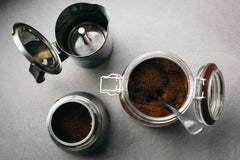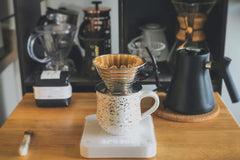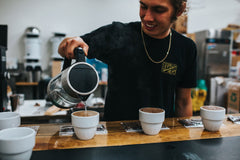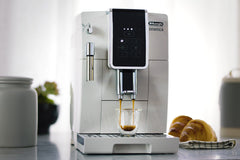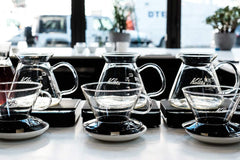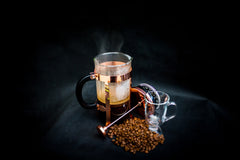At Nomad, we recognize that a great brew starts with a great bean. It’s our job to supply you with the highest quality bean, roasted just right to bring out the best possible flavor.
We ship it to you, fresh from the roaster, so that you’re able to enjoy the sensory experience of opening a package of coffee beans at their peak of freshness.
But from there, it’s up to you.
Once our coffee lands in your hands, you are the brew master, the final artist in the creation of a great cup of coffee. The definition of the perfect cup of coffee changes from one person to the next, and while we’re happy to offer you advice on how to brew, we also know that there are many methods of brewing and that it’s an individual process.
There are however, four components that we consider the basics of a great cup of coffee, no matter what your brewing style. Here, we want to outline them for you and explain how each contributes to the perfect brew.

The Coffee
This is a no brainer. It is impossible to craft the perfect brew without the coffee to start with. Our take is that it can’t be just any coffee. It needs to be the best coffee.
This isn’t to say that one bean or roast is better than another. What we do mean is that what ends up in your cup is the cumulative efforts of the farmer, the roaster and everyone in between.
- Step 1: Start with great coffee. If you subscribe to one of our coffee plans, then we’re not worried. We already know you have the best.
- Step 2: Know what your coffee likes. It seems like we spent decades where every cup of coffee drank came from a drip style coffee machine. This is still a great method of brewing coffee, but we’ve learned to expand our coffee horizons and experiment with other brewing methods. What we’ve discovered is that different coffees love different brewing techniques.
Learn all that you can about your favorite bean and roast, and discover how different brewing methods extract different qualities from the bean. Once you understand this, the rest is easy. Trust us, this is an enjoyable process.
The Grind
We distribute our coffee as whole beans rather than ground because it provides you with a fresher tasting cup of coffee.
When you grind coffee, you automatically increase the surface area of the bean. This means that your ground coffee is now exposed to more air than when it was in whole bean form. Increased exposure to air equals an increased rate of oxidation. Once coffee is ground, it will soon begin to lose some of the subtler flavor characteristics and even begin to take on a bit of stale taste.
We don’t want this for you or your coffee, which is why we suggest waiting to grind your coffee until you are ready to brew.
Both manual grinders and burr grinders come in many shapes and sizes. Some are small and easy to use, while others are large and require the help of your own personal barista to learn how to operate. For grinding just enough beans for one to three cups of coffee, we personally love the Hario Mini Coffee Grinder.
Coffee beans can be ground in several different “levels”. These levels basically define how fine or coarse the grind is, and what extraction method will work best. If your coffee is under extracted, you’ll end up with a brew that is sour and too acidic. If your coffee is over extracted, you get a brew that is bitter and missing many of its subtle flavor notes. The perfect grind is the happy medium.
Some coffee grinders have multiple settings while others offer a straightforward medium grind that is most suitable for drip makers.

Here's a quick rundown of the basic coffee grinds and corresponding brew methods.
- Extra Coarse Grind: This is the largest grind possible on most coffee grinders. Coffee with an extra coarse grind will resemble cracked peppercorns in texture. This grind works best on brews that either use increased temperature to extract flavor from the grind, such as cowboy coffee, or brews that use time to their advantage to maximize extraction, such as with cold brew coffee.
- Coarse Grind: Coarse grind is marginally finer than extra coarse. Its texture is better compared to sea salt than to cracked pepper. Coarse ground coffees are optimal for extraction methods that don’t use a filter, such as French press and percolator brews.
- Medium Coarse Grind: Here, we begin to approach a standard grind, but it is still a bit coarser in texture. This type of grind works great with the Chemex.
- Medium Grind: This is the standard grind that you find in most coffees right off the grocery store shelf. It is sandy in texture and works well in drip coffee makers, cone shaped pour overs and the AeroPress.
- Medium Fine Grind: This grind is the gold standard for many pour over coffee lovers. Being slightly finer in texture than medium grind allows more flavor nuances to come through using the pour over method. This grind works well with most pour over brewers, and is also compatible with the AeroPress using a shorter brew time.
- Fine Grind: This is the second most popular grind that you will find in pre-ground coffee. It works well with pressurized brewing methods like the Moka Pot and espresso extractors. Some coffee drinkers like this grind for their regular pot, but note that your drip filter should be cone shaped rather than flat bottomed to get the most from this grind in your standard coffee maker.
- Extra Fine Grind: This is the probably the least common type of grind that you will find, and most home grinders do not grind this fine, unless you have a pricier specialty model. Extra fine coffee is used to create specialty coffee brews that are thicker and served in smaller portions, such as a Turkish coffee.
Water
Before you start adding your favorite flavorings, there are only two basic ingredients in a cup of coffee. The first is of course the coffee, and the second is water. The quality of both are equally important. In fact, your brewed coffee is up to 98% water, so we shouldn’t overlook the importance of water quality in brewing basics.
As a rule, you can say that if your water tastes good enough to drink on its own, then it is good enough to brew your coffee with. There is nothing wrong with this idea, if you know what is in your water.
Tap water often contains minerals and other elements that can affect the quality of your brew. Another element of tap water than can vary depending upon your location and affect the taste of your coffee is the pH level.
The pH level of water sits in the middle at a neutral 7. Elements in tap water can change the pH, and therefore it’s not uncommon to find tap water with a pH range of 6.5-8.5. These slight differences can make a big difference in how your coffee tastes.
Slightly acidic water, with a pH lower than 7 is good for flavor quality, but not so great for optimal extraction.
On the other hand, slightly basic water, with a pH higher than 7 makes for good extraction, but can affect flavor in an unpleasant way.

The solution? We find a happy medium that is perfect for brewing. This can usually be achieved by running your normal tap water through a filtration system, which will remove some of the impurities without eliminating too much of the mineral content that helps to make your coffee more flavorful. Avoid using distilled or softened water for your coffee, as these can result in a flavorless, flat brew.
Once you have your water ready the next two questions that remain are about ratio and temperature.
If you are using a standard drip brew coffee pot, the best ratio to start with is one to two tablespoon of ground coffee for every six ounces of water. Start here and adjust to suit your personal preferences, keeping in mind that some water is lost during the brewing process due to evaporation and absorption into the grounds.
Finally, we have temperature. The best water temperature for brewing coffee is between 195°-205°F, except for cold brew extraction.
The only time that fully boiling water should meet coffee is with methods like cowboy coffee, where the coarse grind can withstand the heat, without succumbing to over extraction.
Otherwise, if you are brewing your coffee manually, bring the water to a light boil, remove it from the heat and let it cool for just a couple minutes before adding it to the grounds.
Time

The final element of brewing basics is time. The amount of time that water is in contact with the coffee grounds can greatly affect the final flavor.
Brewing too long results in over extraction, while not brewing long enough is a recipe for under extraction. Neither will result in a great cup of coffee.
Here's everything you need to know about proper timing:
- Drip pot coffee maker: this piece of equipment usually does all the timing work for you. A standard brewed coffee will have grounds and water that are in contact with each other for 3-5 minutes.
- Pour over coffee is a two-step process in regard to timing. The first part is how long you spend adding water to the grounds. This determines the timing of the second part, which is how long the coffee drips. You want somewhere between 20-60 seconds of drip time added to pour over time to reach a range of 2.5-4 minutes, depending on the roast.
- When steeping using a French press, contact time should be about 2.5-4 minutes.
- Espresso has a contact time of 20-30 seconds.
- Cold brew coffee has a contact time of anywhere from 12-48 hours.
Brewing great coffee is equal parts intuition and knowledge. It’s so basic, yet filled with science. This is one of the things that we love about coffee. It is such an easily enjoyable part of our lives, but there is always something new that can be learned about it. The next time you take to brewing, stop for a minute and think about the incredible science behind it.
Brewing coffee is an art and a science that we can all enjoy.

